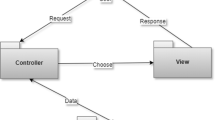Abstract
Automatic discovery and composition of Web services is an important research area in Web service technology, in which the specification of Web services is a key issue. This paper presents a Web service capability description framework based on the environment ontology. This framework depicts Web services capability in two aspects: the operable environment and the environment changes resulting from behaviors of the Web service. On the basis of the framework, a requirement-driven Web service composition model has been constructed. This paper brings forward the formalization of Web service interactions with π calculus. And an automatic mechanism converting conceptual capability description to the formal process expression has been built. This kind of formal specification assists in verifying whether the composite Web service model matches the requirement.
Similar content being viewed by others
References
Endrei M, Ang J, et al. Patterns: Service-Oriented Architecture and Web Services. IBM Redbook, April 2004. http://www.redbooks.ibm.com/abstracts/sg246303.html
Tsalgatidou A. An overview of standards and related technology in Web services. Distrib Parallel Databases, 2002, 12: 135–162
Koehler J, Srivastava B. Web service composition: Current solutions and open problems. In: Proceedings of the 13th International Conference on Automated Planning and Scheduling, Trento, Italy. 2003, 28–35
Christensen E, Curbera F, et al. Web Services Description Language (WSDL) 1.1. W3C Technique Reports, 2001. http://www.w3.org/TR/wsdl
McIlraith S A, Martin D L. Bringing semantics to Web services. IEEE Intell Syst, 2003, 8(1): 90–93
Martin D, Burstein M, et al. OWL-S: Semantic markup for Web services. DAML Services, November 2004. http://www.daml.org/services/owl-s/1.0/
Frank Leymann. Web Services Flow Language. IBM Services, May 2001. http://www-306.ibm.com/software/solutions/webservices/pdf/WSFL.pdf
Arkin A, Askary K, et al. Web Service Choreography Interface (WSCI) 1.0. W3C Technique Report, August 2002. http://www.w3.org/TR/wsci
Andrews T, Curbera F, et al. Business process execution language for Web services version 1.1. IBM Developworks, May 2003. http://www-128.ibm.com/developerworks/library/specification/ws-bpel/
Pratt V. Action logic and pure induction. In: Proceedings of Logics in AI: European Workshop JELIA’ 90 (LNCS). Berlin: Springer-Verlag, 1990. 97–120
Hamadi R, Benatallah B. A petri net-based model for web service composition. In: Proceedings of the 14th Australasian Database Conference (ADC’03). Darlinghurst: Australian Computer Society, 2003. 191–200
Liao J, Tan H, Liu J D. Describing and verifying Web service using Pi-calculus. Chin J Comput, 2005, 28(4): 635–642
Salaun G, Bordeaux L, Schaerf M. Describing and reasoning on Web services using process algebra. In: Proceedings of the 2nd IEEE International Conference on Web Services, San Diego, Carlifornia, USA, 2004. 43–51
Ferrara A. Web services: A process algebra approach. In: Proceedings of the 2nd International Conference on Service Oriented Computing, New York, USA, 2004, 242–251
Jin Z. Revisiting the meaning of requirements. J Comput Sci Technol, 2006, 21(1): 32–40
Hou L S, Jin Z. FECT: A modeling framework for automatically composing Web services. WAIM2005, LNCS-3739, 2005, 320–332
Hou L S, Jin Z. A composition model of Internet components based on environment transitions. Chin J Electr, 2005, 33(12A): 82–87
Milner R. Communication and Concurrency. Englewood Cliffs: Prentice-Hall, 1989
Engburg U, Nielsen M. A calculus of communicating systems with label-passing. Report DAMI PB-208, Computers Science Department, University of Aarbus, 1986
Milner R, Parrow J, Walker D. A calculus of mobile processes, part I/II. J Inf Comput, 1992, 100(1): 1–77
Voctor B, Moller F. The mobility workbench. A tool for the calculus. In: Proceedings of CAV’94: Computer-Aided Verification. Springer-Verlag, 1994, 818: 428–440
Author information
Authors and Affiliations
Corresponding author
Rights and permissions
About this article
Cite this article
Hou, L., Jin, Z. & Wu, B. Modeling and verifying Web services driven by requirements: An ontology-based approach. SCI CHINA SER F 49, 792–820 (2006). https://doi.org/10.1007/s11432-006-2031-5
Received:
Accepted:
Issue Date:
DOI: https://doi.org/10.1007/s11432-006-2031-5




